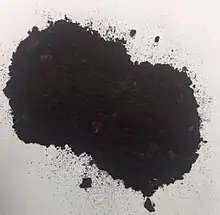9.png.webp) | |
 | |
| Names | |
|---|---|
| Other names
methylidyne-tris(tricarbonylcobalt) | |
| Identifiers | |
3D model (JSmol) |
|
PubChem CID |
|
| |
| |
| Properties | |
| C10HCo3O9 | |
| Molar mass | 441.909 g·mol−1 |
| Appearance | purple solid |
| Density | 2.01 g/cm3 |
| Melting point | 105–107 °C (221–225 °F; 378–380 K) |
Except where otherwise noted, data are given for materials in their standard state (at 25 °C [77 °F], 100 kPa).
Infobox references | |
Methylidynetricobaltnonacarbonyl is the organocobalt compound with the formula HCCo3(CO)9. It is a metal carbonyl cluster that contains the methylidyne ligand. The compound has C3v point group symmetry. It is a purple, air-stable solid that is soluble in some organic solvents, but not in water.
The compound is prepared by the reaction of dicobalt octacarbonyl with bromoform. Much of the cobalt(0) is consumed in the formation of cobalt(II) bromide. An idealized equation for the synthesis is:[1]
- 9 Co2(CO)8 + 4 CHBr3 → 4 HCCo3(CO)9 + 36 CO + 6 CoBr2
Many analogues are known, including the benzylidyne (C6H5C), arsinidyne (As), and chloromethylidyne (ClC) derivatives, respectively C6H5CH2CCo3(CO)9,[1][2] AsCo3(CO)9, and ClCCo3(CO)9.[3] The potential of some analogues as catalysts for hydroformylation – including with acylidyne and arylidyne moieties – has been investigated.[4]
The structure has been analyzed by X-ray crystallography. The Co-Co distances are near 2.48 Å in length.[5] The structure is related to that of dicobalt hexacarbonyl acetylene complexes and tetracobalt dodecacarbonyl, which are also tetrahedranes.
References
- 1 2 Nestle, Mara O.; Hallgren, John E.; Seyferth, Dietmar; Dawson, Peter; Robinson, Brian H. (2007). "μ3-Methylidyne and μ3-Benzylidyne-Tris(Tricarbonylcobalt)". Inorganic Syntheses. Vol. 20. pp. 226–229. doi:10.1002/9780470132517.ch53. ISBN 9780470132517.
{{cite book}}:|journal=ignored (help) - ↑ Johns, Denise M.; McAuliffe, Charles A. (2007). "Cobalt – Carbonyls". In Johnson, Brian F. G. (ed.). Inorganic Chemistry of the Transition Elements. Vol. 5. Royal Society of Chemistry. pp. 211–213. ISBN 9781847556462.
- ↑ Brown, Alisdair James (1995). Functionalised Transition Metal Clusters of Cobalt and Osmium (PhD thesis). The University of Edinburgh.
- ↑ Seyferth, Dietmar; Withers, Howard P. (1983). "Alkylidynetricobalt nonacarbonyl complexes as hydroformylation catalysts". Inorg. Chem. 22 (20): 2931–2936. doi:10.1021/ic00162a033.
- ↑ Leung, P.; Coppens, P.; McMullan, R. K.; Koetzle, T. F. (1981). "The Structure of Nonacarbonyl-μ3-methylidyne-triangulo-tricobalt. X-ray and Neutron Diffraction Studies". Acta Crystallogr. B. 37 (7): 1347–1352. doi:10.1107/S0567740881005906.